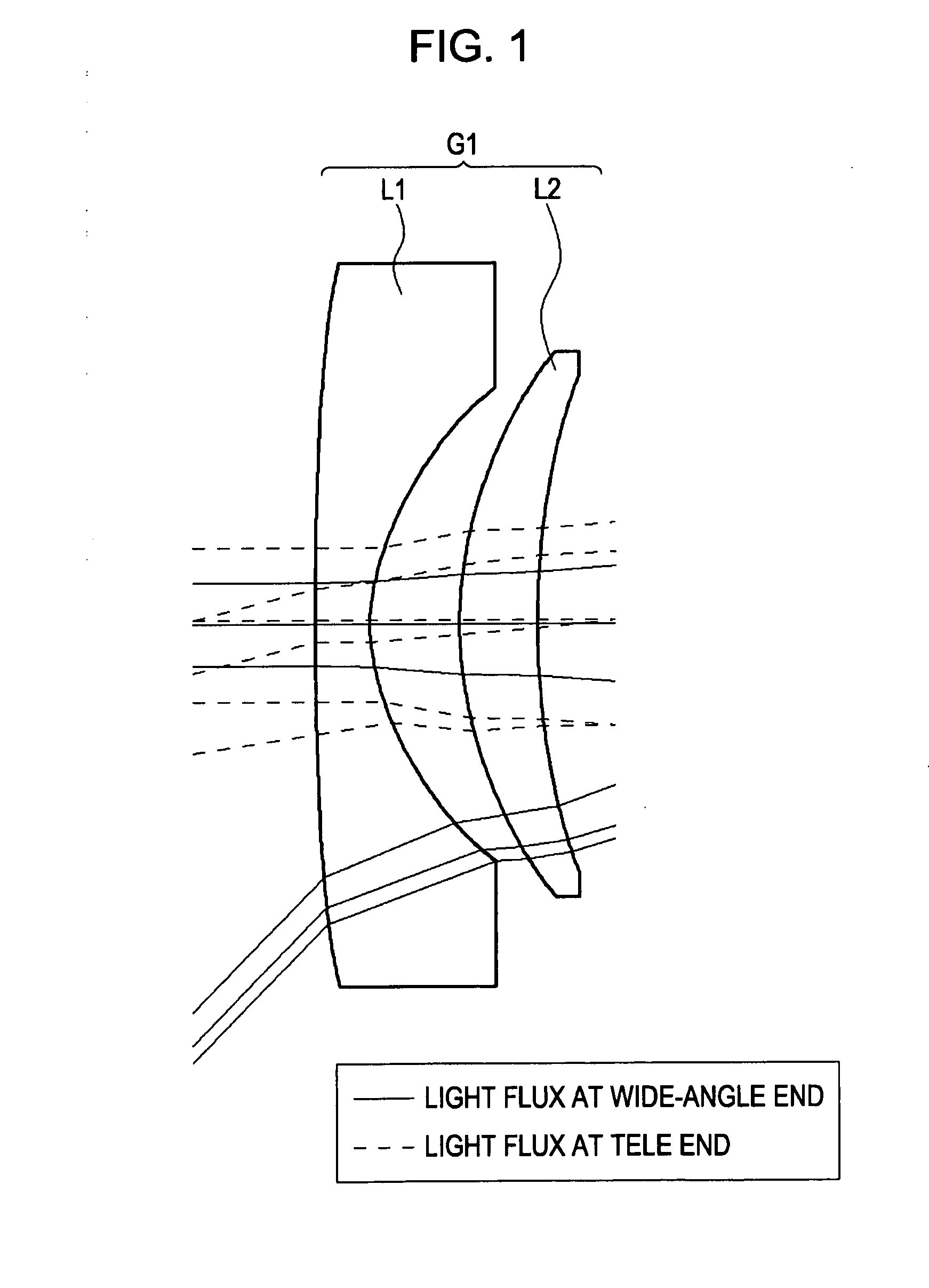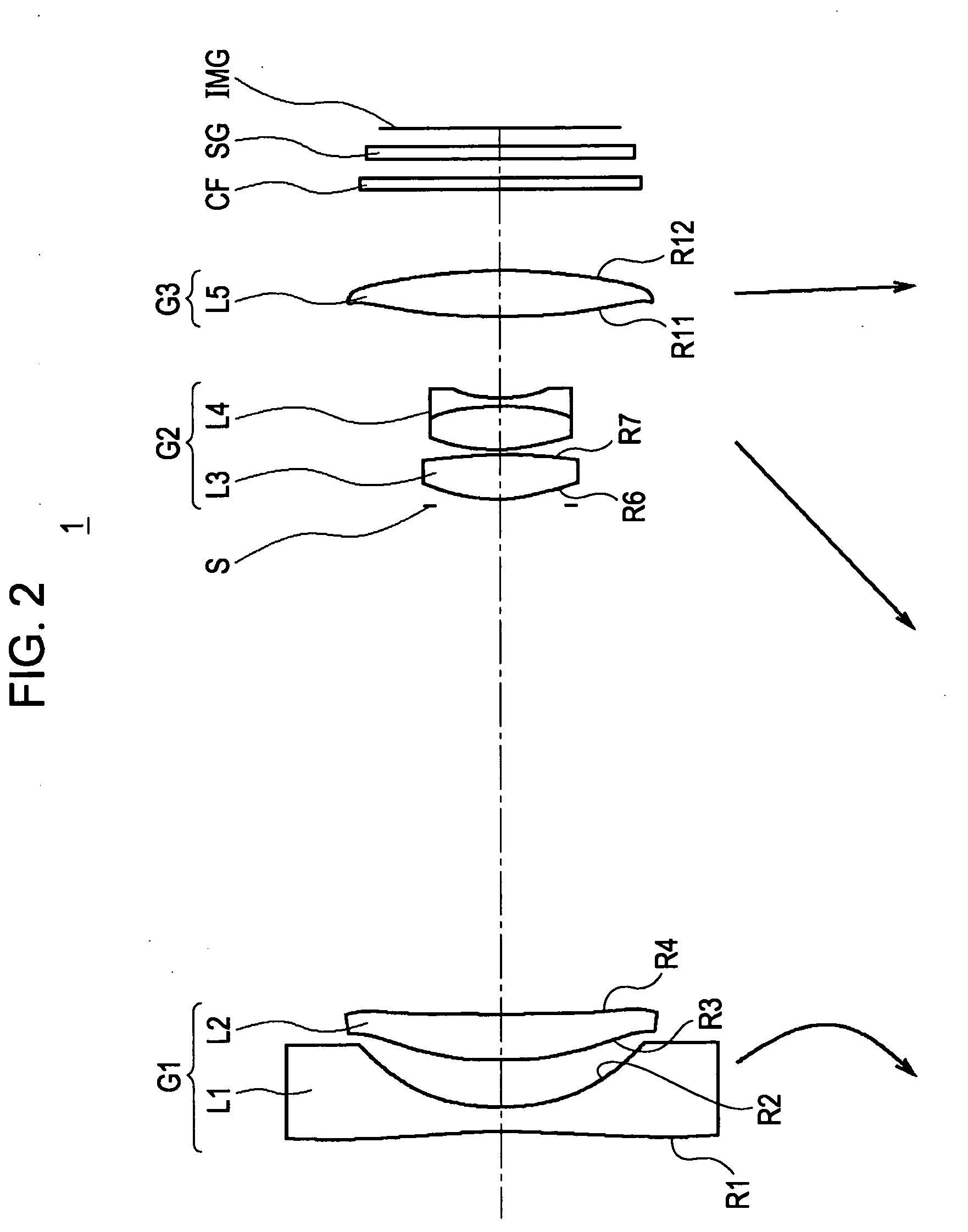Zoom lens and imaging apparatus
a technology of zoom lens and zoom lens, which is applied in the field of zoom lens and imaging apparatus, can solve the problems of over-all length being too long, and achieve the effects of reducing the size of the entire lens, good astigmatism correction, and long length
- Summary
- Abstract
- Description
- Claims
- Application Information
AI Technical Summary
Benefits of technology
Problems solved by technology
Method used
Image
Examples
first embodiment
1. First Embodiment
1-1. Configuration of Zoom Lens
[0055]According to a first embodiment of the present invention, a zoom lens includes a first lens group having negative refractive power, a second lens group having positive refractive power, and a third lens group having positive refractive power, in that order from the object side. At the time of changing power from a wide-angle end state to a tele end state, the first lens group moves such that air space between the first lens group and the second lens group decreases, and air space between the second lens group and the third lens group increases, and the second lens group moves toward the object side. The first lens group includes two lenses, which are, in order from the object side toward the image side, a first lens which is a negative lens of which both faces are formed aspherically with the concave face facing the image side, and a second lens which is a positive meniscus lens of which at least one face is formed aspherically...
first numerical embodiment
2-1. First Numerical Embodiment
[0089]In FIG. 2, reference numeral 1 denotes a zoom lens according to the First Numerical Embodiment, configured of a first lens group G1 having negative refractive power, a second lens group G2 having positive refractive power, and a third lens group G3 having positive refractive power, in that order from the object side.
[0090]The zoom lens 1 is configured such that, at the time of changing power from the wide-angle end state to the tele end state, the first lens group G1 moves such that air space between the first lens group G1 and the second lens group G2 decreases, and air space between the second lens group G2 and the third lens group G3 increases, and the second lens group G2 moves toward the object side.
[0091]The first lens group G1 includes, in order from the object side toward the image side, a first lens L1 which is a biconcave lens of which both faces are formed aspherically, and a second lens L2 which is a positive meniscus lens of which th...
second numerical embodiment
2-2. Second Numerical Embodiment
[0102]In FIG. 6, reference numeral 2 denotes a zoom lens according to the Second Numerical Embodiment, configured overall of a first lens group G1 having negative refractive power, a second lens group G2 having positive refractive power, and a third lens group G3 having positive refractive power, in that order from the object side.
[0103]The zoom lens 2 is configured such that, at the time of changing power from the wide-angle end state to the tele end state, the first lens group G1 moves such that air space between the first lens group G1 and the second lens group G2 decreases, and air space between the second lens group G2 and the third lens group G3 increases, and the second lens group G2 moves toward the object side.
[0104]The first lens group G1 includes, in order from the object side toward the image side, a first lens L1 which is a biconcave lens of which both faces are formed aspherically, and a second lens L2 which is a positive meniscus lens o...
PUM
 Login to View More
Login to View More Abstract
Description
Claims
Application Information
 Login to View More
Login to View More - R&D
- Intellectual Property
- Life Sciences
- Materials
- Tech Scout
- Unparalleled Data Quality
- Higher Quality Content
- 60% Fewer Hallucinations
Browse by: Latest US Patents, China's latest patents, Technical Efficacy Thesaurus, Application Domain, Technology Topic, Popular Technical Reports.
© 2025 PatSnap. All rights reserved.Legal|Privacy policy|Modern Slavery Act Transparency Statement|Sitemap|About US| Contact US: help@patsnap.com



